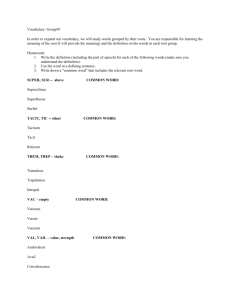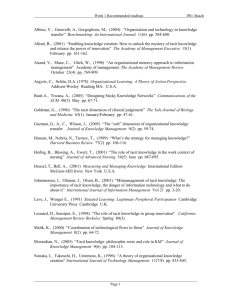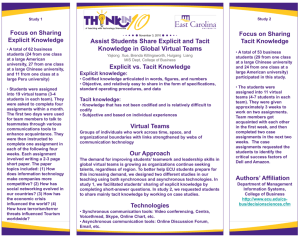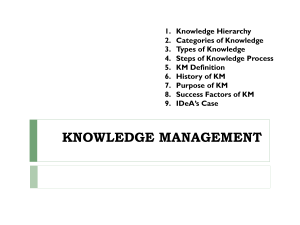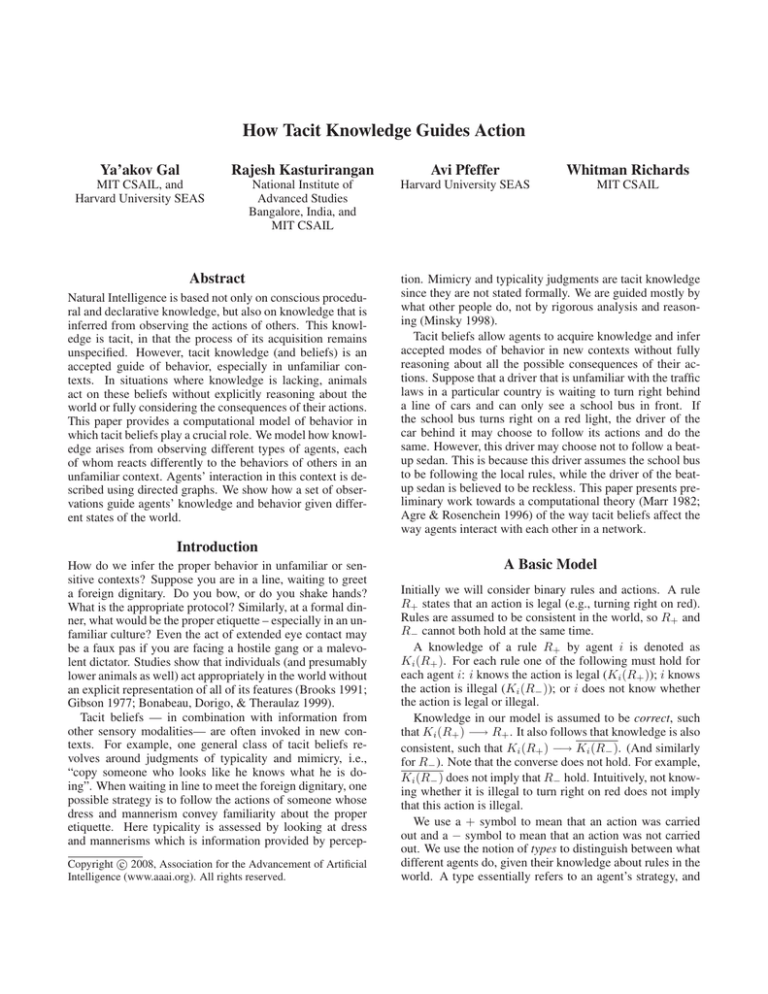
How Tacit Knowledge Guides Action
Ya’akov Gal
Rajesh Kasturirangan
Avi Pfeffer
Whitman Richards
MIT CSAIL, and
Harvard University SEAS
National Institute of
Advanced Studies
Bangalore, India, and
MIT CSAIL
Harvard University SEAS
MIT CSAIL
Abstract
Natural Intelligence is based not only on conscious procedural and declarative knowledge, but also on knowledge that is
inferred from observing the actions of others. This knowledge is tacit, in that the process of its acquisition remains
unspecified. However, tacit knowledge (and beliefs) is an
accepted guide of behavior, especially in unfamiliar contexts. In situations where knowledge is lacking, animals
act on these beliefs without explicitly reasoning about the
world or fully considering the consequences of their actions.
This paper provides a computational model of behavior in
which tacit beliefs play a crucial role. We model how knowledge arises from observing different types of agents, each
of whom reacts differently to the behaviors of others in an
unfamiliar context. Agents’ interaction in this context is described using directed graphs. We show how a set of observations guide agents’ knowledge and behavior given different states of the world.
tion. Mimicry and typicality judgments are tacit knowledge
since they are not stated formally. We are guided mostly by
what other people do, not by rigorous analysis and reasoning (Minsky 1998).
Tacit beliefs allow agents to acquire knowledge and infer
accepted modes of behavior in new contexts without fully
reasoning about all the possible consequences of their actions. Suppose that a driver that is unfamiliar with the traffic
laws in a particular country is waiting to turn right behind
a line of cars and can only see a school bus in front. If
the school bus turns right on a red light, the driver of the
car behind it may choose to follow its actions and do the
same. However, this driver may choose not to follow a beatup sedan. This is because this driver assumes the school bus
to be following the local rules, while the driver of the beatup sedan is believed to be reckless. This paper presents preliminary work towards a computational theory (Marr 1982;
Agre & Rosenchein 1996) of the way tacit beliefs affect the
way agents interact with each other in a network.
Introduction
How do we infer the proper behavior in unfamiliar or sensitive contexts? Suppose you are in a line, waiting to greet
a foreign dignitary. Do you bow, or do you shake hands?
What is the appropriate protocol? Similarly, at a formal dinner, what would be the proper etiquette – especially in an unfamiliar culture? Even the act of extended eye contact may
be a faux pas if you are facing a hostile gang or a malevolent dictator. Studies show that individuals (and presumably
lower animals as well) act appropriately in the world without
an explicit representation of all of its features (Brooks 1991;
Gibson 1977; Bonabeau, Dorigo, & Theraulaz 1999).
Tacit beliefs — in combination with information from
other sensory modalities— are often invoked in new contexts. For example, one general class of tacit beliefs revolves around judgments of typicality and mimicry, i.e.,
“copy someone who looks like he knows what he is doing”. When waiting in line to meet the foreign dignitary, one
possible strategy is to follow the actions of someone whose
dress and mannerism convey familiarity about the proper
etiquette. Here typicality is assessed by looking at dress
and mannerisms which is information provided by percepc 2008, Association for the Advancement of Artificial
Copyright Intelligence (www.aaai.org). All rights reserved.
A Basic Model
Initially we will consider binary rules and actions. A rule
R+ states that an action is legal (e.g., turning right on red).
Rules are assumed to be consistent in the world, so R+ and
R− cannot both hold at the same time.
A knowledge of a rule R+ by agent i is denoted as
Ki (R+ ). For each rule one of the following must hold for
each agent i: i knows the action is legal (Ki (R+ )); i knows
the action is illegal (Ki (R− )); or i does not know whether
the action is legal or illegal.
Knowledge in our model is assumed to be correct, such
that Ki (R+ ) −→ R+ . It also follows that knowledge is also
consistent, such that Ki (R+ ) −→ Ki (R− ). (And similarly
for R− ). Note that the converse does not hold. For example,
Ki (R− ) does not imply that R− hold. Intuitively, not knowing whether it is illegal to turn right on red does not imply
that this action is illegal.
We use a + symbol to mean that an action was carried
out and a − symbol to mean that an action was not carried
out. We use the notion of types to distinguish between what
different agents do, given their knowledge about rules in the
world. A type essentially refers to an agent’s strategy, and
this strategy is specific to each type of agent. 1 I For example, consider the action of turning right on a red light. We
can define the following types for agent i:
• t1 (conservative). Choose action − (Never turn right on
red)
• t2 (law abiding). Choose action + if Ki (R+ ) (Turn right
on red only if you know it is legal)
• t3 (risk taker). Choose action + if Ki (R− ). (Turn right
as long as you don’t know it is illegal)
• t4 (reckless). Choose action + (Always turn right on red)
The way in which agents interact with each other in our
model is defined by a directed network called an interaction
graph. Each node in the network represents a type of agent.
We assume that agents have tacit knowledge of the types
of agents they interact with, and they use this knowledge
as a surrogate for what is true in the world. In an interaction graph, an edge from agent ti to agent tj means (1) that
agent tj knows the type of agent ti , and (2) that agent tj
can observe the action of type ti . In the traffic example, the
following network represents a possible instantiation of an
interaction graph in which there is a line of cars, where an
agent of type t3 is waiting behind an agent of type t1 who is
waiting behind an agent of type t2 , etc...
t4 → t2 → t1 → t3
The following table summarizes what actions are taken by
each agent type, given its neighbors. We list the actions for
a row agent i given that its neighbor is the column agent j
that chooses action + (left entry in a column) and action −
(parenthetical right entry in a column). A ∅ symbol denotes
a counter-factual event — an action that cannot be chosen
by a given type under the circumstances.
t1
t2
t3
t4
t1
∅ (−)
∅ (−)
∅ (+)
∅ (+)
t2
− (−)
+ (−)
+ (+)
+ (+)
t3
− (−)
− (−)
+ (−)
+ (+)
t4
− (∅)
− (∅)
+ (∅)
+ (∅)
We say that agent i conveys knowledge if its actions provide information about rules in the world, or about the
knowledge of other agents about rules in the world. Consider for example an edge (t4 , t2 ) in a possible interaction
graph for the traffic example, meaning that an agent of type
t2 is waiting behind an agent of type t4 . Suppose that the t2
agent does not know whether R+ or R− hold. The t4 agent
always turns right, so it doesn’t convey additional knowledge to the t2 agent. Since t2 is law-abiding, it will choose
action −. In contrast, consider an edge (t4 , t3 ) and that
Ki (R− ) holds for the agent of type t3 . In this case, the
t3 agent will choose action +, because the actions of the
t4 have not revealed that R− holds. To summarize, we can
infer the following about types t1 , . . . , t4 in an interaction
graph.
1
Our use of types in this work is distinguished from the traditional usage of this term as representing agents’ private information
in game theory.
• Types t1 and t4 never convey knowledge because the
strategies of these types do not depend on knowledge of a
constraint.
• Type t3 conveys Ki (R− ) when it is observed to do −, and
conveys Ki (R− ) when it is observed to do +.
• Type t2 conveys Ki (R+ ) when it is observed to do + and
conveys Ki (R+ ) when it is observed to do −.
We can now state the following:
Theorem 1. Let C be an interaction graph. An agent j of
type t2 in C will choose action + if and only if the following
hold:
• There is an agent i in C such that Ki (R+ ) holds.
• There is a directed path in C from i to j that passes solely
through agents of type t2 .
Similarly, an agent t3 will do − when Ki (R− ) holds and
there is a path from i to j that passes solely through agents
of type t3 .
This theorem is easy to prove. Take for example a path
from R+ to an agent of type t2 . Any agent along this path
that is not of type t2 will not convey knowledge of R+ to
t2 , and therefore t2 will do −, as specified by the table. The
argument is similar for a path from R− to an agent of type
t3 .
A corollary of Theorem 1 is that any knowledge that is
conveyed to an agent in an interaction graph is consistent. To
see this, suppose both Ki (R+ ) and Ki (R− ) hold for some
agent i in an interaction graph. By Theorem 1, both R+
and R− will be descendants of i, which cannot be the case,
because rules are consistent.
Using the theorem, we can induce a mapping from any
agent i and interaction graph C to a knowledge condition for
i, stating that i knows the rule is legal (Ki (R+ )), i knows
the rule is illegal (Ki (R− )), or that i does not know (∅).
Note that agents convey knowledge based on their types and
are not perfect reasoners given the structure of the graph.
For example, consider a network t2 → t3 , in which Ki (t2 )
holds. Agent t2 would do −, and according to the table, agent t3 would do +, because it cannot infer whether
Ki (R− ) holds for the agent in front of it. However, if t3
knew the structure of the graph it would be able to infer
Ki (R− ) from the action of t2 and the fact that t2 can observe R− .
A Generative Model of Types
A type is a mapping from a set of possible knowledge predicates for an agent to an action. The number of possible
knowledge predicates depend on the number of rules, and
the number of values each rule can take. In the traffic example, either Ki (R+ ) or Ki (R− ) can hold for each agent (and
similarly for R− ). We consider any instantiation of these
conditions that is consistent in the world as a valid knowledge predicate. The possible knowledge predicates the traffic example are as follows:
1. {Ki (R+ ), Ki (R− )}
2. {Ki (R− ), Ki (R+ )}
3. {Ki (R+ ), Ki (R− )}
Note that the set {Ki (R+ ), Ki (R− )} cannot occur because
of the consistency condition of our model.
Thus, an agent of type t3 (risk taker) chooses action +
if (1) and (3) hold, while an agent of type t2 (law abiding)
chooses action + solely if (1) holds. Types t1 and t4 choose
action + and action − respectively for all possible sets of
knowledge predicates.
In general, if there are n binary rules, there are three possible sets of knowledge predicates for each rule, and the total
number of possible sets is thus 3n . A type is a mapping from
each of these sets to an action + or −, so the number of posn
sible types is 2(3 ) , which is doubly exponential in the number of rules. However, using Theorem 1, we can enumerate
determine the knowledge and the actions of particular agents
without having to enumerate all types.
We now show that t1 , . . . t4 is not an arbitrary subset of
the 23 = 8 possible types in the traffic example. Let S be
a complete order over knowledge predicates. We say that a
knowledge predicate i dominates j if i j in S. In the traffic example, we impose an ordering (2) (3) (1). Intuitively, this ordering represents a degree of severity. Knowing an action is illegal is the highest degree of severity,
whereas knowing that an action is legal is the lowest degree.
We then say that a type ti is monotonic if for any two
knowledge predicates K1 , K2 such that K1 K2 the following holds: if ti chooses action a1 in K1 , and a1 ∈
K1 , a2 ∈ K2 then a1 a2.
It turns out that all of the types in our traffic example are
monotonic with the ordering imposed above. For example,
it is sufficient to characterize a risk taker type t3 as doing −
under knowledge condition (2), in which R− is known and
choosing to do + under knowledge condition (3), in which
R− is not known. Given the ordering we’ve imposed above,
it follows that t3 will choose to do “+” under knowledge condition (1), in which R+ is known. As an example of a nonmonotonic type, consider a “malicious” agent that chooses
action + solely under knowledge condition (2). This agent
chooses + when it knows R− , and chooses − when it knows
R+ . Another example is one that drives at least 45 MPH
even if it does not know the legal speed limit, never drives
above 65 MPH, and drives at the maximal speed x it knows
to be legal where 45 < x < 65.
Multiple Actions
We now turn to the case in which there are multiple possible
actions to consider. Consider the speed of the car as a discrete variable, where each value represents that the speed of
the car is within a possible interval of speeds, say 10 MPH.
Suppose that the minimal and maximal speed of a car are
min and max, respectively. A rule in this example, denoted
Ry denotes that the maximal driving speed is y. There is a
natural ordering over knowledge predicates in this scenario,
mainly that Ki (Ry ) Ki (Rz ) for every z ≤ y. We need
only consider types that are monotonic with respect to this
ordering. Thus, a type tyi implies that agent i drives at speed
y or below. The set of monotonic types we introduced for
the binary case generalize to the multi-value case. A law
abiding agent type drives at speed y or below if it knows
Ry . Otherwise it drives at a minimal speed of min. A risk
taker agent type drives at speed z as long as it does not know
Ry . If it knows Ry , it drives at speed z if z ≤ y and at speed
y if z > y.
The following table summarizes what actions are taken by
each agent type, given its neighbors. We list the actions for
a row agent i given that its neighbor is the column agent j
that is observed to be driving at speed y. We use notation
“RT” to refer to a risk taking agent and “LA” to refer to a
law abiding agent.
LA
RT
LA
≤y
≥ y, ≤ z
RT
min
≤ y, ≤ z
A law abiding agent always conveys that the speed limit
is y. Thus a risk taker that is observing a law abiding agent
in the network that is driving at speed y will always drive at
a speed that is greater or equal to y. However, a risk taker
never conveys the speed limit, and a law abiding agent that
observes it can only drive at the minimal speed.
We can also extend Theorem 1 to fit this case. A law abiding agent type t will drive at speed y (or below) if there is
an agent i in the interaction graph for which Ki (Ry ) holds,
and a path from this agent to t that is composed solely of law
abiding agents. (and similarly for a risk taking agent).
Discussion
The interaction graph in our traffic example above was a
simple directed chain, with four different types of nodes arranged in an arbitrary order. There are many other forms of
interaction graphs. Obvious cases are a leader of a group
(connected graph), or when everyone can see everyone else
(complete graph), a bipartite graph, random graphs, etc.
With only 8 nodes, there are 1012 possible forms (Harary
1969). Note that Theorem 1, however, is general and lays
out a condition where knowledge of the graph form and
node types can lead to a correct action. Theorem 1 illustrates
the larger claim that whenever tacit knowledge is governed
by underlying principles such as the global consistency of
knowledge, agents have enough information to do the right
thing. In our case, the rules and types were all categorical.
Other cases, however, may require probabilistic inferences.
We will discuss some of these extensions and conditions for
correct inference.
The other interesting computational element in our model
is the use of monotonicity as a constraint to address a difficult inverse problem, namely, to infer the right action based
on observations of other agents behavior. In general, there
cannot be a unique solution to the problem of right action.
However, the assumption that people fall into types constrains the inference procedure. However, types alone are
not enough. We need to assume that both types of agents
and the set of observations are structured in a partial ordering. In our traffic example, types are ordered according to
their response to punishment (reckless to conservative). We
also assume that agents knowledge is ordered as well, i.e.,
that no one ever knows less than she knew before so observations always increase knowledge. These two are distinct
partial orders but they are related, for whenever there is a
scale of punishment, it helps if observations help rather then
hurt.
Finally, although the inference process may in some cases
be complex, our main intent is to present a simple representation for evaluating how tacit beliefs and knowledge can
lead to correct actions in unfamiliar contexts. The fact that
tacit knowledge is largely implicit, suggests how lower animals as well as humans can learn appropriate behaviors
without directed examples and tutors.
References
Agre, P., and Rosenchein, S. 1996. Computational Theories of Interaction and Agency. MIT Press.
Bonabeau, E.; Dorigo, M.; and Theraulaz, G. 1999. Swarm
Intelligence: From Natural to Artificial Systems. Oxford
University Press.
Brooks, R. A. 1991. Intelligence without representation.
artificial intelligence. Artificial Intelligence 47:139–159.
Gibson, J. J. 1977. The theory of affordance. In Shaw, R.,
and Bransford, J., eds., Perceiving, Acting, and Knowing.
Harary, F. 1969. Graph Theory. Addison-Wesley.
Marr, D. 1982. Vision. Freeman and Co.
Minsky, M. 1998. The Society of Mind. Simon and Schuster. 302–303.

